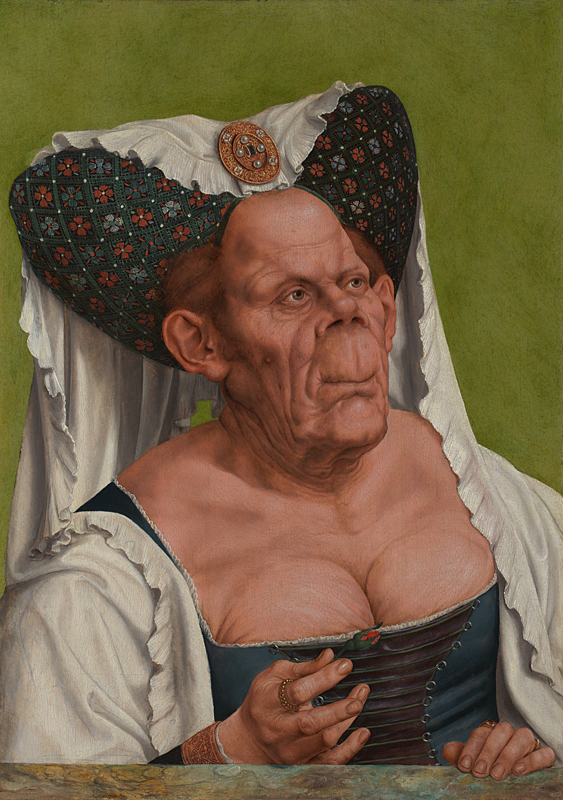Quinten Massys’ The Ugly Duchess is the subject of an exhibition at the National Gallery UK during the springtime. Massys was a prominent painter in Antwerp in the early 16th century. As the title suggests, this painting depicts an elderly woman in a grotesque manner. This picture could be seen as satire rather than a harsh joke. It may show how society stereotypes women, particularly older women.

https://www.nationalgallery.org.uk/paintings/NG5769
When I see this painting, I am a bit perplexed: Is the subject an old woman or a man? Also, some questions come to my mind: If it is a woman, why is she depicted with such a large headdress and a low-cut dress? Is this the beauty standard at that time? Or is she depicted as a perverted woman? Or is it an insult to elderly women?
Another possibility is male cross-dressing. What was the purpose of male cross-dressing in the Renaissance? As quoted from Johnová (2009), cross-dressing practice can be found in Renaissance Shakespeare’s comedies, but it was usually a noble woman who became a boy of a lower status. Since women were considered inferior to men and had fewer rights, female cross-dressing aims to get more freedom and rights. (Lucie Johnová, 2009)
How about male cross-dressing? In Elizabethan theater, the female roles were played by men because the public theater in England at that time was a domain of men. (Lucie Johnová, 2009) So, was the man in the painting an actor? Or, a worse possibility, could it be a mockery of an old woman?
As Carola Long notes in her article, I am also unsure of how to understand this artwork as a contemporary viewer. However, this painting presents how women or old women are represented in art. It seems that old women are often depicted as cruel or evil.

The bust of a grotesque old woman c.1510-20. Royal Collection Trust. National Gallery London.
https://www.rct.uk/collection/912492/the-bust-of-a-grotesque-old-woman
Massys’s The Ugly Duchess is displayed together with a drawing by Leonardo da Vinci, The bust of a grotesque old woman, that has a similar appearance of an old woman. The original version of Leonardo has been lost; only this copy is left, made by his pupil and heir Franceszo Melzi.
The name “The Ugly Duchess” became known after John Tenniel used this image to draw the Ugly Duchess in his illustrations to Lewis Carroll’s Alice’s Adventures in Wonderland, published in 1865.
To call this painting “the ugly duchess” itself shows the way patriarchal society sees an old woman as evil or a witch.
Quinten Massys. Portrait of an old man. (1517). https://commons.wikimedia.org/wiki/File:Quentin_Massys-Portrait_of_an_Old_Man,1517,Mus%C3%A9e_Jacquemart-Andr%C3%A9,Paris.jpg
In this exhibition, the ugly duchess meets her companion painting, An Old Man. It was supposed that Massys created “a parody of the traditional marriage portrait” through both paintings. Another perspective says the Duchess can also be seen as a subversive and fierce figure.
Whatever way this painting could be interpreted, I think that Massys’s Duchess is opening up a discussion about how society stigmatized elderly women. Until now, the art and entertainment worlds still recognize the value of looking young and attractive for women.
The Ugly Duchess: Beauty and Satire in the Renaissance is on view through June 11, 2023, at the National Gallery, London, UK.
How does this painting link Leonardo da Vinci to Alice’s Adventures in Wonderland? | The National Gallery
